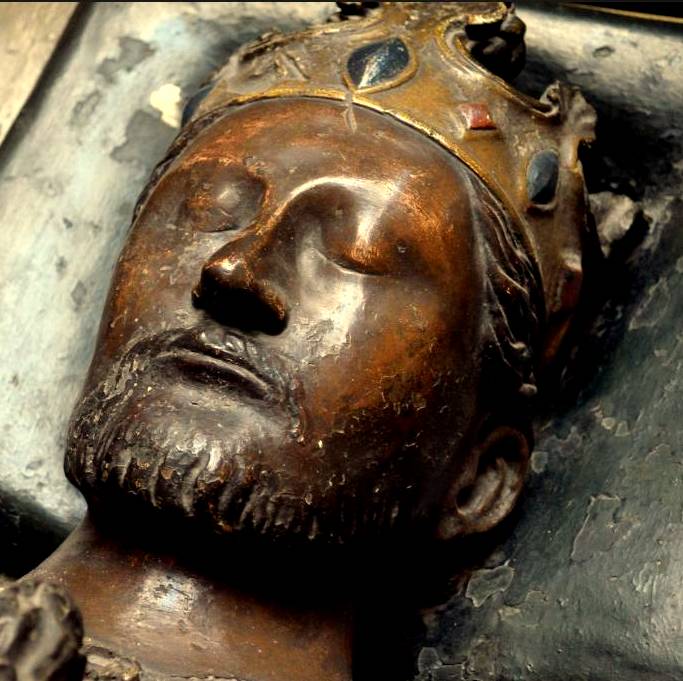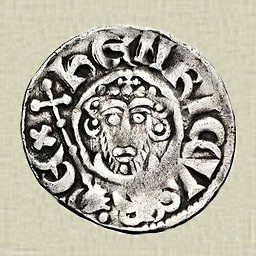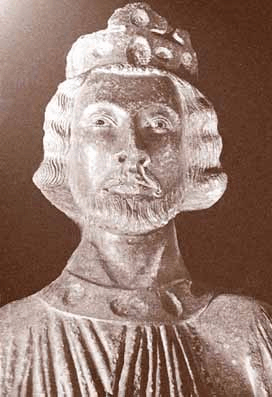1189
DEATH OF HENRY II and accession of Richard I.

1190
DEATH OF ADAM DE BRUS II. He was buried in Guisborough Priory and was succeeded by his son, Peter de Brus I.
Peter de Brus I had to pay a fee of 500 marks [1 mark = 13s 4d = two thirds of a pound]] for his father’s lands, on doing fealty on the succession.
1196
Peter married Agnes, the widow of William de Romara, Earl of Lincoln.
She was the daughter of Stephen, Earl of Albemarle and Holderness and by this marriage Peter acquired Manors in that area. Agnes died in the same year.
1198
Peter re-married to Joan, whose ancestry not traced.
1199
DEATH OF RICHARD I. His brother John was crowned on the 27th May.
1200
Peter de Brus I of Skelton Castle gave up his interest in the Lordship of ‘Berdesey, Colingham and Ringston’ and paid King John £1000 for the Lordship and forest of Danby. ‘Rotuli de Oblatis’ 1200:-
‘Peter de Brus has restored and quit-claimed to our Lord the King and his heirs for ever, the vills of Berdsey and Colingham and Rington, with all their appurtenances, as well in advowsons of churches, as in demesne lands, fees, homages, services, reliefs, and in all other matters to the said vills pertaining, without any reserve, in exchange for the vill of Daneby, with all its appurtenances, and the forest of Daneby, which the King has restored to the said Peter and his heirs, to be held of him and his royal heirs by the service of one knight, in lieu of the aforesaid vills which King Henry, the father of the now king, had formerly given to Adam de Brus, the father of the said Peter, in exchange for the said vill and forest of Daneby.
And the said Peter is to deliver over to our Lord the King the aforesaid vills free and quit from all those who have been enfeoffed in them by himself or his said father during the time they had been held by them or either of them.
And in consideration of the eager desire entertained by the said Peter for the compassing of this exchange, and at his instant prayer for the same, he has induced our Lord the King to receive from him one thousand pounds sterling, two hundred and fifty marks [one mark = 13s 4d] whereof is to be paid into the Treasury at Easter now instant, and thereafter two hundred and fifty from Treasury- term to term, until the whole shall have been paid up.
As Pledges for the fulfulment hereof, William de Stuteville stands bound in 100 marks; Henry de Nevill in 60 marks; Hugo Bard in 40 marks; Robert de Ros in 200 marks; Eustace de Vesci in 200 marks; Robert Fitzroger in 100 marks.
And the said Peter’s bond is delivered to William de Stuteville, who together with Robert de Ros and Eustace de Vesci, undertakes that the said Peter, at the first ensuing Court of the County of York, shall find sufficient pledges for the remainder of his obligation, and such that our lord the King shall obtain full satisfaction for the same’

Peter de Brus supported King John in the first years of his reign and was witness to 13 of his Charters up to 1213 and fulfilled his military obligations.
In return he received consideration for his debts to the Crown.
While Peter de Brus I was guardian of the area round Hartlepool for his cousin Robert, he claimed some wrecks of the coast which had been taken by the Bishop of Durham’s servants.
For this he was fined 50 shillings and in response took captive one of the bishops men, Gerard de Seaton, and locked him up in Skelton Castle.
For this he was excommunicated by the Bishop, who was named Poor, and fined a further 20 pounds by the Justices.
Peter’s father-in-law, William, the Earl of Albemarle intervened with the Bishop and had the sentences quashed on condition the Bishop had total rights to sea wrecks.
Peter gave moorland and woodland between Guisborough and Danby to Guisborough Priory, retaining the right of common pasture and hunting.
He also donated Glaisdale moor and ‘Swineheved’, Rosedale head, for pasture for cattle and timber supplies.
At a later date he gave his smithy at Glaisdale with the right of taking iron ore anywhere within the Glaisdale area.
1203
King John, who received Peter de Brus’s support at this time reduced the Lord of Skelton Castle’s debt payments by 400 pounds per annum.
1204
FAMINE – To 1205. This winter was one of the severe winters of history and many rivers were frozen completely;
The frost prevented ploughing and all agricultural work was suspended from 14th January to 22nd March, the winter seed was destroyed and there was widespread famine.
Peter de Brus offered 200 marks and 2 palfreys [Riding horses] to have seisin [conveyance of legal ownership] of the Manors of Carlton and Camblesforth, held of the Paynels.
Robert Fitz Roger, Constable of Chester, and Peter de Brus, paid a fine of 40 marks to have Marmaduke de Thweng in their custody.
1205
Peter de Brus offered 25 marks and a “palfrey” to have the seisin [conveyance of ownership] of Lofthouse of the honor of Chester.
1206
The wardship and marriage of Roger Bertram, a minor at his father’s death, given to Peter de Brus for 1300 marks in exchange against the debts of William Briwerre.
1207
Peter I acquired the Liberty of Langbaurgh, thus becoming Lord and Chief Bailiff of the Wapentake of Langbaurgh.
By this the crown allowed him the right to certain fees, tolls, control of weights and measures, to hold certain Courts.
Peter quitted of £200 for a forest plea; his debts to the Crown totalled 1,235 pounds, plus 5 palfreys and 2 hunting dogs; with an annual repayment of 400 pounds.
1208
In the Feudal System all land was considered to be owned by the Crown and sub-let to the Barons and through them to their knights and tenants.
Similarly the Crown had Rights to charge the Barons arbitrary amounts and Fines, which seem to have been based purely on the King’s financial requirements at the time.
Barons, like Peter de Brus, had to pay a large sum on their succession, at which time they had to swear “fealty” to the monarch. They had to serve in the King’s forces or pay a fine instead – “scutage” etc.
The Barons in turn had to find what amounted to Royal Taxes by making similar charges of their knights and tenants in the form of Rent and various fines and charges in their own local Courts and Markets etc.
There was clearly much scope for abuse and consequent grievance by those who had to pay which at times led to open revolt.
In this year to obtain the money demanded by King John Peter de Brus made an agreement with his Cleveland tenants within Langbaurgh, by which he agreed to limitations in the exercise of his authority in return for a guarantee that the knights and free tenants would make up any shortfall in the rent of forty marks charged by the king.
Witnesses:-
Roger de Lacy [Rogero Constabulario Cestria], Robert de Ros, Eustachia de Vescy, Walter de Faucumberge.
This Charter was lodged with the Prior of Guisborough. It has been suggested by some that it was a pre-cursor to Magna Carta, when the Barons strove to place similar limitations on King John’s powers.
Peter de Brus was given custody of William de Brus, the son of William, as a hostage of King John to ensure the behaviour of the King of Scotland.
Peter de Brus held 11 “knights fees” of the honour of “Skeltone” in Yorkshire.
1211
Peter had paid off all the debts acquired with his inheritance.
1212
King John made a grant to Finchale Priory. Peter de Brus was a witness at the city Durham.
1213
Peter de Brus was among the Barons who met King John when he came North.
John ordered Peter to release William de Brus, who had been held hostage in Skelton Castle, and deliver him to Portsmouth.
In this year King John took a military force to Poitou.
Peter was one of those who refused to serve in it.
Later in the year joined John’s force, which had assembled at Barham Down in Kent to defend against a French invasion that was never made.
1214
Peter was assessed “scutage” for failing to join King John in Poitou. He did not pay.
King John called upon his barons to aid him in his war with France, but many and most of the northern ones no longer had any landed interests in France and declared they were not bound to give their service.
BOUVINES – In July John was defeated in the battle of Bouvines in present day Belgium and lost his continental possessions.
1215
MAGNA CARTA. In January the northern barons [including Peter de Brus] forced King John to sign the Magna Carta at Runnymede in an attempt to curb his despotic rule.
CIVIL WAR – John soon ingnored any restrictions and Civil War began.
Peter de Brus and other Barons including Robert de Roos and William de Percy supported Louis, the heir to the French throne against John.
In September John acquired a mercenary force from France and waged war on his barons.
William de Brus, the 3rd Lord of Annandale in Scotland was brought to Guisborough and buried in the Priory along with his family.
At some unknown date his wife, Christiana was buried alongside him.
Peter de Brus with Robert de Ros and Richard de Percy rebelled and brought Yorkshire under their control. They were offered 1000 marks by the citizens of York not to plunder the city.
1216
In January king John moved North against the rebellious barons.
He seems to have operated out of Knaresborough Castle, which was then and is still Crown property.
‘He began to lay waste the northern parts of England, to destroy the castles of the barons, or compel them to submit to his order, burning without mercy all their towns, and oppressing the inhabitants with tortures to extort money.’
On the 6th February John was at Guisborough:-
‘Peter de Brus has Letters of safe conduct from King John to last from the Sunday next after the Purification of the Blessed Virgin for the eight following days, issued from Gyseburn’.
SKELTON CASTLE TAKEN – From the 8th to the 10th the king attacked and took Skelton Castle.
Peter de Brus’s men were taken prisoner.
On the 15th John agreed to receive Peter de Brus and Robert de Ros under safe conduct:-
‘with all such as they should bring with them unarmed, to a conference, to treat with him about making their peace with him; and the said safe conduct shall hold good for one month from St Valentine’s day.
And for greater security our lord the King wills that …..Archdeacon of Durham, Wydo de Fontibus, Frater Walter, Preceptor of the Templars in the district of Yorkshire, with one of Hugh de Bailloel’s retinue, shall go with them in person to the Lord King, and escort them; and they have Letters Patent from the King to that effect;
and the said letters are the same day handed to the aforesaid parties, Thomas, Canon of Gyseburn, being further added to their numbers’
On the 26th king John issued the following mandate:-
‘We command you that you receive and see to the safe keeping of the prisoners whose names are underwritten, taken at Skelton Castle, who will be sent to you by Dame Nicholas de Haya –that is to say, Godfrey de Hoga, Berard de Fontibus, Anketil de Torenton, Robert de Molteby, Stephen Guher, William de Lohereng, Robert de Normanby, Roger le Hoste, Robert de Gilling, John de Brethereswysel, Thomas Berard’sman and Ralph de Hoga’
In July and August the king issued further orders that prisoners taken at Skelton Castle should be ransomed.
20th May –
FRENCH INVASION – Prince Louis of France invaded England at the invitation of the disatisfied barons.
He crossed to England in 10 warships, with 1200 knight and 900 troops and quickly captured all the Cinque Ports except Dover, held by Hubert de Burgh.
Louis captured the town of Lincoln, but not the castle.
DEATH OF JOHN and accession of his son, Henry III, aged 9.
The cause of the civil strife disappeared with John’s death.
Magna Carta was re-issued in Henry’s name. Many of the baron’s changed sides and now opposed Prince Louis of France.

Retouched photograph of the effigy
on his tomb in Worcester Cathedral.
Next Page – 1216 to 1272.
Previous Page – 1119 to 1188.
Contents Page.